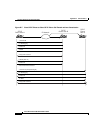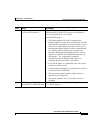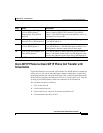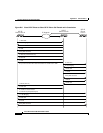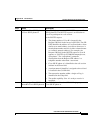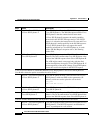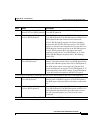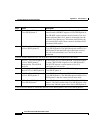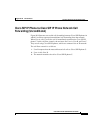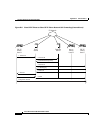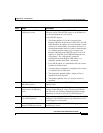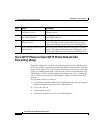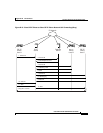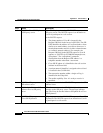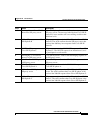
Appendix B SIP Call Flows
Call Flow Scenarios for Successful Calls
B-40
Cisco SIP IP Phone 7960 Administrator Guide
78-10497-02
14
BYE—Cisco SIP IP phone B to
Cisco SIP IP phone A
The call continues and then User B hangs up. Cisco SIP IP
phone B sends a SIP BYE request to Cisco SIP IP phone A.
The SIP BYE request includes the Also header. The Also
header indicates that User C needs to be brought into the
call while User B hangs up. The header distinguishes the
call transfer BYE request from a normal disconnect BYE
disconnect BYE request.
15
200 OK—Cisco SIP IP phone A
to Cisco SIP IP phone B
Cisco SIP IP phone A sends a SIP 200 OK message to
Cisco SIP IP phone B. The 200 OK response notifies Cisco
SIP IP phone B that the BYE request has been received.
The call session between User A and User B is now
terminated.
The RTP channel between Cisco SIP IP phone A and Cisco SIP IP phone B is torn down.
16
INVITE—Cisco SIP IP phone A
to Cisco SIP IP phone C
(Requested by Cisco SIP IP
phone B)
At the request of Cisco SIP IP phone B, Cisco SIP IP phone
A sends a SIP INVITE request to Cisco SIP IP phone C.
The INVITE request is an invitation to User C to
participate in a call session.
17
180 Ringing—Cisco SIP IP
phone C to Cisco SIP IP phone A
Cisco SIP IP phone C sends a SIP 180 Ringing response to
Cisco SIP IP phone A.
18
200 OK—Cisco SIP IP phone C
to Cisco SIP IP phone A
Cisco SIP IP phone C sends a SIP 200 OK response to
Cisco SIP IP phone A. The 200 OK response notifies Cisco
SIP IP phone A that the connection has been made.
19
ACK—Cisco SIP IP phone A to
Cisco SIP IP phone C
Cisco SIP IP phone A sends a SIP ACK to Cisco SIP IP
phone C. The ACK confirms that Cisco SIP IP phone A has
received the 200 OK response from Cisco SIP IP phone C.
A two-way RTP channel is established between Cisco SIP IP phone A and Cisco SIP IP phone C.
Step Action Description



